The Twelfth
| A small number of parades by the Orange Order have been the subject of controversy, and have attracted a large amount of attention in the media. The media interest is understandable, but may give a misleading impression. The vast majority of parades take place without any problems, and are enjoyed by tens of thousands of people across Northern Ireland. |
|
The Orange tradition is only one aspect of unionism, but probably the most colourful and distinctive one. I was brought up in a rural area where the annual parade in July was one of the highlights of the year. I am not an Orangeman, but I still enjoy watching the parades. This page shows some pictures which I took during one of the main parades in Northern Ireland, on Monday 13th July 1998.
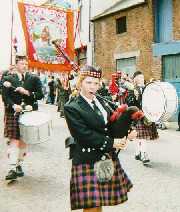 One of several pipe bands on parade - 51k |
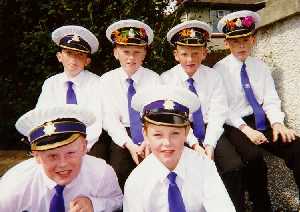 Young band members waiting for the start of the parade - 69k |
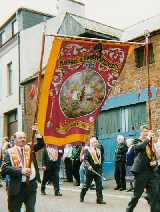 A typical banner of King William III - 46k |
In the morning, the local lodges and bands marched to the start of the parade route, to meet the buses arriving from other districts. The main parade then started, crossing the town towards the "field". At the field, there was plenty of time to have a picnic lunch and chat to old friends.
Most of the Orangemen gathered for a short religious service at the field conducted by the chaplains from the various districts. At the close of the service, members of the platform party proposed three resolutions. This year, as normal, they pledged loyalty to the Queen, reaffirmed the importance of religious faith and practice, and supported the continued union of Northern Ireland with Great Britain. Of course, the resolutions were heartily endorsed by the audience!
After the service, there was time to buy some publications from the bookstall. Booklets were available on King William III, the formation of the Orange Order, the significance of the Glorious Revolution and the 1798 Rebellion. On the return route, local bands and members stopped in the town centre to applaud the brethren and bands from other districts, as they completed their march to the waiting buses.
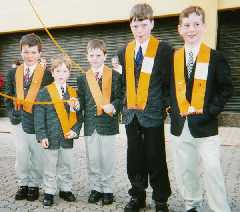 Five brothers who are all junior members - 56k |
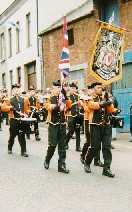 Colour party with a bannerette - 39k |
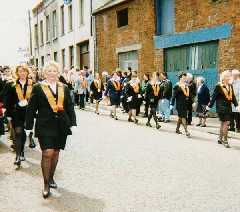 Orangewomen marching to the field - 61k |
The pictures of William III at the Boyne, the Mountjoy in the Foyle, and Sir Edward Carson give important insights into the identity of many unionists. It could be said that pictures of Cathleen ni Houlihan, Wolfe Tone and Michael Collins are used in a similar way by many Irish nationalists.
Clearly the status of Northern Ireland is still in dispute. The agreement signed on the 10th April 1998 allows for a poll every seven years to decide whether Northern Ireland should remain part of the United Kingdom, or become part of a united Ireland.
The pictures from the Boyne and siege of Londonderry imply some continuity between the dangers faced by the settlers in 1689-90, and the current struggle to protect Northern Ireland's status as part of the UK. Like any historical analogy, it relies to some extent on a simplified view of history. The same reservations could be expressed about the usage of the 1798 rebellion by nationalists.
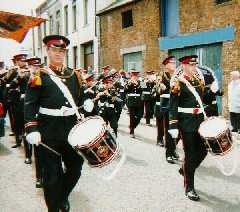 One of the many flute bands on parade - 68k |
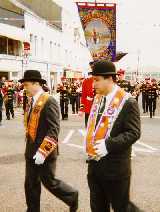 Lodge office-bearers - 41k |
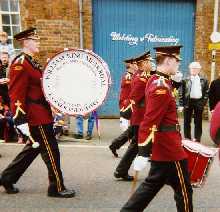 All Ireland champions from Londonderry - 58k |
The usage of historical imagery from several hundred years ago is not unique to unionists and nationalists in Northern Ireland. The anniversaries of Independence Day in the United States of America (4th July 1776) and of the storming of the Bastille in France (14 July 1789) are also marked by celebrations. In fact, a sense of identity flows from these historical events: events which may take on increased importance when that identity is perceived to be under threat.
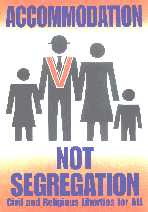 |
See also: |
 |
Cruithni website | Home | FAQ | Links | Contact | Updated: 31 December 2001